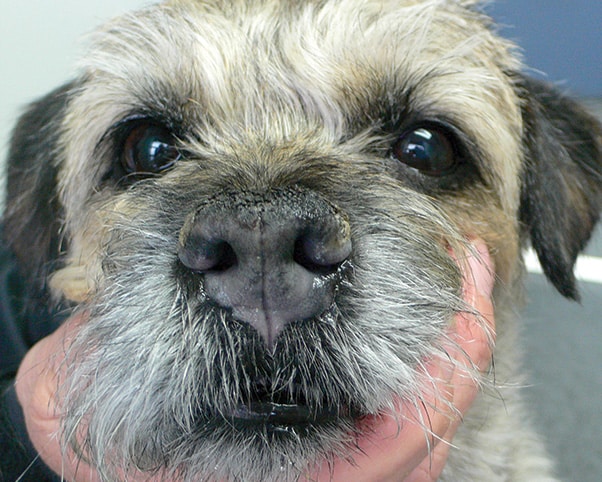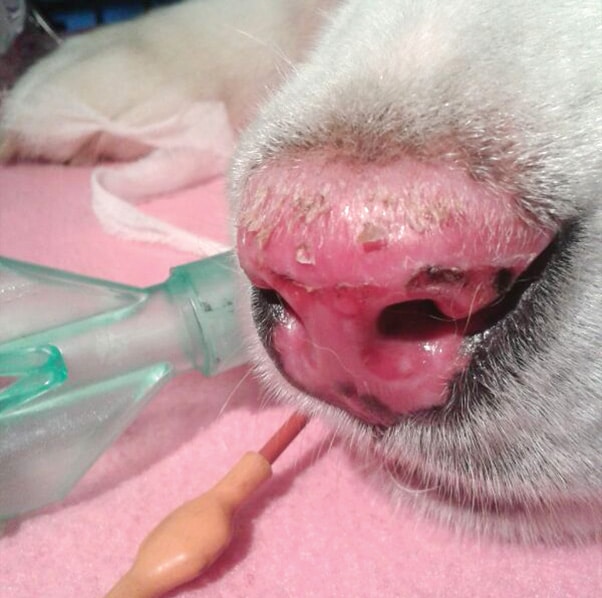What is DLE?
Discoid lupus erythematosus (DLE) is a relatively common autoimmune skin disease of dogs. Autoimmune disease occurs when the immune system targets harmless cells of the body resulting in inflammation and disease. In DLE, skin disease tends to occur around the nose, but can extend to include areas around the eyes, lips and ears. It is distinct from other forms of lupus in dogs that can cause systemic or internal disease along with more widespread skin disease.
What causes DLE?
The exact causes of DLE are not known, although genetic, hormonal and environmental factors are likely to be involved as they are in the human disease. In particular, sun exposure is likely to exacerbate or even induce the lesions of DLE.
What are the clinical signs?
DLE usually starts with a loss of pigmentation from the nose, which takes on a slate gray or blueish colour. The normal ‘cobblestone’ appearance of the nasal planum is lost and areas of inflammation, crusting and ulceration develop (Figures 1 and 2). The ulcerated lesions often start at the junction between the haired skin and the nasal planum, and then extend up the bridge of the nose over time. In severe cases, bleeding can be seen from the ulcerated lesions. Despite the marked skin lesions, affected dogs often seem relatively unaffected by the condition.
In very rare cases, lesions have been reported affecting the legs, footpads and around the anus.

Figure 1 Depigmentation with loss of the ‘cobblestone’ appearance in a Border Terrier with DLE

Figure 2 Loss of pigment and marked crusting on the nose of a Labrador with DLE
How is it diagnosed?
The disease can be suspected based on a review of the history and assessment of the clinical signs. Definitive diagnosis is achieved with a biopsy of affected skin, which can be tricky given the sensitive areas affected around the face. For this reason, biopsies to diagnose DLE are usually performed under general anaesthesia.
What treatments are available?
As DLE is caused by an abnormal immune response, treatment is centred on trying to reduce the inflammation. DLE is usually a localised disease, so effective control can often be obtained without the need for potent drugs given by mouth.
Topical creams and gels containing steroids or drugs called calcineurin inhibitors can be applied directly to the affected skin if animals are tolerant, and this approach helps to minimise side effects typically seen with oral medications.
If oral medication is required, the combination treatment of oxytetracycline and niacinamide is often helpful and is usually tolerated well with very few side effects. Vitamin E and fatty acid supplements are other options for milder cases of DLE and in more severe cases once disease is controlled. If clinical signs are severe, oral steroid medication is often required. In all cases, sunlight exposure must be minimised with avoidance strategies and the use of sunscreens
What is the outlook/prognosis?
The prognosis for DLE is usually good, and disease usually remains limited to small areas of the skin. However, DLE is usually controlled rather than cured, and many cases need long term medication. Some cases can follow a more severe course, requiring more powerful drugs to control the disease.
If you have any queries or concerns, please do not hesitate to contact us.
Arranging a referral for your pet
If you would like to refer your pet to see one of our Specialists please visit our Arranging a Referral page.